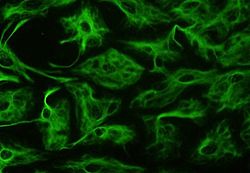Glial cell


Glial cells are support cells for the nervous system. In Greek, Glia means "glue". Glia are said to be the glue of the nervous system.[1] Glia occur in both grey matter and white matter.
Glia are thought to have four main functions:
- To surround neurons and hold them in place,
- To supply nutrients and oxygen to neurons,
- To insulate one neuron from another,
- To destroy pathogens and remove dead neurons.
Glia may have more functions than just these four.[2]
Types of Macroglia
| Location | Name | Description |
|---|---|---|
| CNS | Astrocytes | Astrocytes form the blood-brain barrier and guide axons. |
| CNS | Oligodendrocytes | Oligodendrocytes are cells that form a myelin sheath, which coats the axons of neurons (to make impulses travel faster) in the Central Nervous System. These are the opposite of Schwann Cells. |
| PNS | Schwann cells | Schwann Cells are very similar to oligodendrocytes in that they form the myelin sheath, but they do it for the neurons located in the Peripheral Nervous System. They also clear cellular debris to allow for the regrowth of neurons |
| CNS | Ependymal cells | Ependymal cells create and secrete cerebrospinal fluid, which surrounds the brain and spinal cord. |
| PNS | Satellite cells | Satellite cells are small cells that help regulate the external chemical environment. |
Role in degenerative brain diseases
A type of glial cell is thought to play a role in amyotrophic lateral sclerosis (ALS or motor neurone disease), Alzheimer's disease (a type of dementia) and Parkinson's disease.
The microglia are the macrophages of the nervous system. In these neurodegenerative disorders, it is thought that the microglia digest healthy brain cells, causing the degeneration of brain function. This is especially true for Parkinson's disease, where the Glia break down dopaminergic cells, causing the symptoms associated with Parkinson's.[3][4]
Glial Cell Media
Astrocytes can be identified in culture because, unlike other mature glia, they express glial fibrillary acidic protein (GFAP)
Neoplastic glial cells stained with an antibody against GFAP (brown), from a brain biopsy
References
- ↑ 'Glue' is what the word glia means in Greek.
- ↑ Scientific American. The other brain cells
- ↑ Annals of the New York Academy of Sciences [2003, 991:214-228] (Europe Pubmed)
- ↑ Annals of Neurology [1998, 44(3 Suppl 1):S115-20] (Europe Pubmed[dead link])




